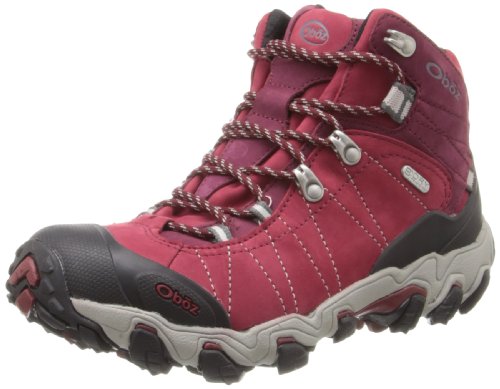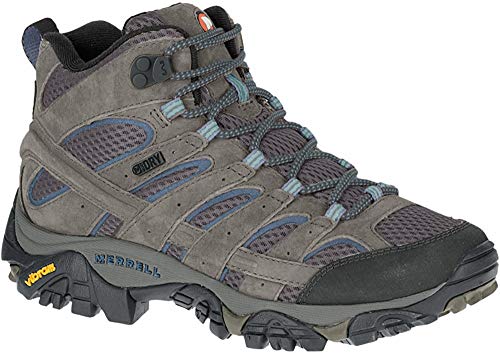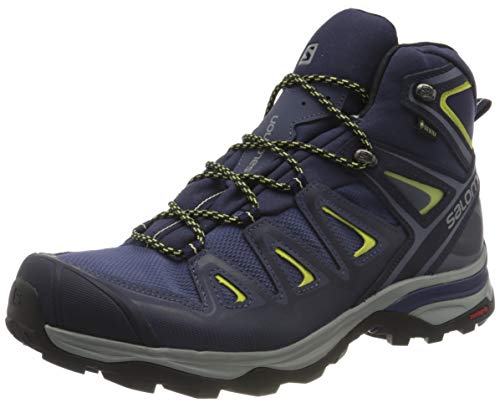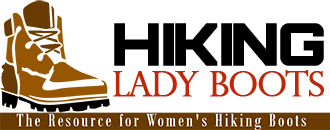Best Women’s Hiking Boots (Reviews) for Orthotics
If you’ve been hiking for a short amount of time, you have noticed that wearing the proper pair of hiking boots can make a difference. Even if bunions, plantar fasciitis, or other feet conditions aren’t life-threatening, they can still affect life quality and make hiking difficult.
Hiking may not be the best activity for people with foot conditions, but the proper hiking boots will give you the right amount of padding, arch and ankle support, expansive toe room, or other features you need for best comfort.
Top Women’s Hiking Boots for Orthotics
1. Oboz Women’s Bridger B-Dry Hiking Boot
Not only that, Oboz Women’s Bridger B-Dry Hiking Boot are made for the typical shape of women’s feet, but they are also rugged and dependable for various hikes.

See reviews and pricing on Amazon
The nubuck leather used on the upper part is soft and will adjust to your foot’s shape with each wear, whereas the build will improve comfort. The toe room is expansive for comfort for the toes, but it’s also made with molded rubber for best protection against impact, rocks, and stone bruising. The heel is well made and contoured for a snug secure of the heel.
Soft support is essential when dealing with various foot conditions. The boots come with high-density EVA sculpted arch for superior support and a deep EVA heel cup for best stability. The EVA pods will work for rebound and shock absorbency. The TPU chassis counts for torsional stability on all trails, and the single-density EVA provides soft support on all tracks. The boots come with a nylon shank for approval of the heel and forefoot.
Your feet will stay dry while hiking as the boots have a moisture-wicking comfort top layer and waterproof technology for blocking water get inside and help moisture escape from the shoes. Maybe the profile could be slimmer, but the shoes remain a durable and reliable option with space for orthotics and almost all features you need for hiking.
2. Merrell Women’s Moab 2 Mid Waterproof Hiking Boot
Lightweight and waterproof, the Merrell Women’s Moab 2 Mid Waterproof Hiking Boot presents all the features you need for hiking and the removable insole for customization. You may easily add your orthotics for the best comfort and support.

See reviews and pricing on Amazon
The boots’ upper body is made with 100% suede leather and mesh and will fit like a glove sooner than expected. The heel’s air cushion will absorb shock, whereas then select dry will block water from getting inside the boots, allowing moisture to get out from the shoes. No water will get inside, and your feet don’t get sweaty either.
The wide build and spacious toe box are comfortable for the toes, reducing your toes’ pressure. The targeted padding counts for shock absorbency and even weight distribution inside the boots. The tongue and collar are padded for soft support of the ankle and protection against debris and small rocks.
The rubber sole is made with Vibram for best support and traction on all surfaces. The 5mm deep lugs ensure an aggressive grip on all tracks. Even if the boots don’t use most technical trails for a long time, they remain dependable for various hikes when you need to use orthotics.
3. Salomon Women’s X Ultra 3 Mid Gtx W Hiking Boots
Designed for women’s particular foot shape, the Salomon Women’s X Ultra 3 Mid Gtx W Hiking Boots serve both the entry-level and the experienced hikers, which explains the popularity.

See reviews and pricing on Amazon
You won’t have to deal with the break-in period as the upper body is made 100% synthetic. Even if the boots are soft and comfy out of the box, they are tough and made for hiking’s most challenging adventures.
Several features recommend the boots for people who use orthotics. The wide fit allows you to use orthotics, and the energy cell midsole features high-performant EVA foam for shock absorbency and soft support. The boots are supportive and lightweight but tough and durable.
The heel stays in place while hiking, and the risk of slippage is reduced. Two kinds of rubber were used for the sole, ensuring adequate grip and traction. The heel area is patterned for better grip, and the asymmetrical chassis gives padding and support for hiking.
The mudguard around the foot’s base will protect the medial and later areas when you’re taking the muddy tracks. The mesh upper protects against debris, which could cause blistering if getting inside the boots. Even if they’re not made with leather, the shoes are just as durable as leather boots and look very nice.
How should you choose hiking boots for orthotics?
If you’re hiking every time you have some spare time on your hands, you most likely need to buy a good pair of hiking boots. And if you regularly wear orthotics, you should also wear them in the hiking boots. For best fit, you should always have the orthotics on you when selecting the hiking boots. It’s going to make all the difference.
Apart from a good fit, you will need to pay attention to several features of your hiking boots:
Materials & weight
Where you’re hiking and which type of hiking you’re able to do will require a specific type of boots. It would help if you had tough and more massive boots for intense hiking and backpacking and lighter boots for summer or light hikes.
Full-grain leather boots are the more massive and most durable boots, whereas mesh boots make the lightest choice. They’re also stiffer than mesh boots, and if you’re heavily backpacking, you need the extra support and stiffness for better spreading of the weight.
Even if the boots’ material affects the weight of the footwear, the build and other features (laces, hooks, sole, outsole, and the amount of padding) will also count for the final weight of the boots.
Support
Several features will create support for the feet, and they’re not always obvious. Padded collar and tongue will provide ankle support, whereas contoured heel will secure the heel and sustain the ankle.
Stability shank, EVA midsole, and tough outsole will also count for support inside and outside, providing comfort while hiking.
Heavily backpacking and intense hiking will require boots with superior support for the ankle, arch, or heel.
Traction and grip
No matter which foot condition you’re dealing with, you will always need to rely on your boots’ grip and traction. Thick soles will protect the feet against impact and shock of hiking, whereas the padded midsole and your orthotics will help with the pressure and create soft support inside.
Vibram soles are the most representative, as they’re both rigid and flexible enough for dependable grip and traction on most surfaces. Look for soles resistant to slippage, come with mudguard, and are the all-terrain type for increased versatility.
Waterproof & breathable
If you’re hiking in wet areas with numerous wet trails and rainy weather, you should always choose waterproof boots. You never know how the weather will shift in a day, so it’s still wise to choose waterproof or at least water resistant boots.
Even if the boots block water from getting inside the shoes, you don’t want your feet to get sweaty. Ventilation inside the shoes is also essential for dry feet, so the shoes also have to be breathable.
Ease of use
When you’re using orthotics, you want to insert them easily whenever you’re using the boots. Boots with wide openings always make the right choice.
Also, look for boots with speed lacing and d-rings. Not only that, but they’re more durable, but they’re also allowing comfortable and fast lacing/un-lacing while on the road.
FAQs
Q: Should you use orthotics or not?
A: If you’re continually dealing with knee, back, joint pain, the chances are you need to use orthotics. The foot’s discomfort, numbness, or other problems in the foot are easy to solve with orthotics.
Q: Is there a difference between regular boots inserts and custom orthotics?
A: The custom orthotic is made to support and fit your feet perfectly, improving the pain and comfort. Your back, knees, and hips will hurt less as the orthotics will correct your foot and ankle’s functioning and movement. They improve mobility and reduce the pressure on your joints.
Shoe inserts may also help, but they’re not going to correct the alignment and function as well as custom orthotics.
Q: What’s the fastest way to see if you need orthotics?
A: The wet test is the easiest way to see if you should use orthotics or not. If your arch is normal, you will see half of the arch not touch the ground when stepping your wet foot on the floor.
If your arch is high, you will see less of the foot touching the ground, whereas a flat foot will display more filling in the footprint. Unless you have a normal arch, you should think about using orthotics.


